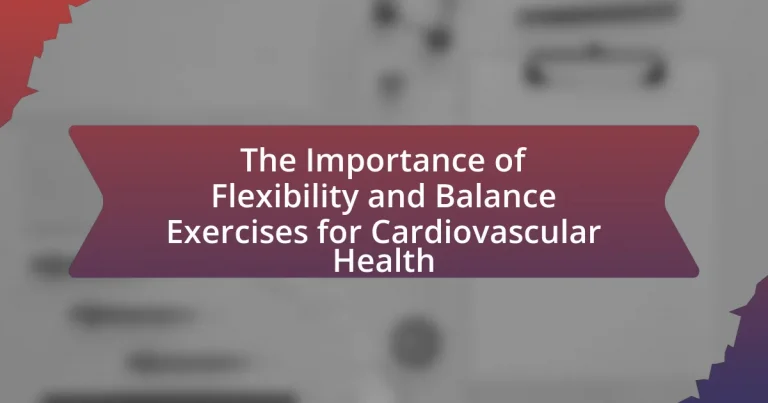The article focuses on the significance of flexibility and balance exercises in promoting cardiovascular health. It outlines how these exercises enhance physical function, improve circulation, and reduce the risk of injury, thereby contributing to better cardiovascular outcomes. Key findings from research indicate that individuals who regularly engage in flexibility and balance training experience improved heart efficiency, lower blood pressure, and enhanced overall cardiovascular fitness. The article also emphasizes the importance of these exercises across different age groups, detailing their unique benefits for children, adults, and older adults, as well as practical tips for integrating them into a comprehensive fitness routine.

What is the role of flexibility and balance exercises in cardiovascular health?
Flexibility and balance exercises play a crucial role in cardiovascular health by enhancing overall physical function and reducing the risk of injury. These exercises improve the range of motion in joints, which can lead to better performance in cardiovascular activities such as walking, running, and cycling. Research indicates that individuals who incorporate flexibility and balance training into their routines experience improved circulation and heart efficiency, contributing to better cardiovascular outcomes. For instance, a study published in the Journal of Cardiopulmonary Rehabilitation and Prevention found that participants who engaged in regular flexibility and balance exercises showed significant improvements in cardiovascular fitness markers compared to those who did not.
How do flexibility and balance exercises contribute to overall cardiovascular fitness?
Flexibility and balance exercises enhance overall cardiovascular fitness by improving blood circulation and reducing the risk of injury during aerobic activities. These exercises promote better range of motion in joints, which facilitates more efficient movement patterns during cardiovascular workouts, such as running or cycling. Improved flexibility allows for greater muscle efficiency, leading to enhanced endurance and performance. Additionally, balance exercises strengthen core muscles, which support proper posture and alignment, further optimizing cardiovascular exercise effectiveness. Research indicates that individuals who incorporate flexibility and balance training into their routines experience lower heart rates and improved cardiovascular responses during physical activity, demonstrating a direct link between these exercises and cardiovascular health.
What specific cardiovascular benefits are associated with improved flexibility?
Improved flexibility is associated with several specific cardiovascular benefits, including enhanced blood circulation and reduced risk of cardiovascular diseases. Enhanced flexibility allows for better blood flow through the arteries and veins, which can lower blood pressure and improve overall heart function. Research indicates that individuals with greater flexibility often experience lower levels of arterial stiffness, which is a significant risk factor for heart disease. Additionally, flexibility exercises can contribute to better physical performance and endurance, leading to increased cardiovascular fitness.
How does balance training impact heart health?
Balance training positively impacts heart health by enhancing overall physical stability and reducing the risk of falls, which can lead to injuries that strain the cardiovascular system. Improved balance contributes to better coordination and muscle strength, allowing individuals to engage in more physical activities, which are essential for maintaining cardiovascular fitness. Research indicates that regular participation in balance exercises can lead to lower blood pressure and improved heart rate variability, both of which are indicators of better heart health. For instance, a study published in the Journal of Aging and Physical Activity found that older adults who engaged in balance training showed significant improvements in cardiovascular function compared to those who did not participate in such exercises.
Why are flexibility and balance exercises essential for different age groups?
Flexibility and balance exercises are essential for different age groups because they enhance physical stability, reduce the risk of injury, and improve overall functional movement. For children and adolescents, these exercises support proper growth and development, promoting coordination and agility, which are crucial for sports and daily activities. In adults, maintaining flexibility and balance helps prevent musculoskeletal injuries and supports joint health, while in older adults, these exercises are vital for fall prevention and maintaining independence. Research indicates that regular participation in flexibility and balance training can significantly decrease the incidence of falls in older adults by up to 30%, highlighting their importance across all age groups.
What are the unique cardiovascular needs of older adults regarding flexibility and balance?
Older adults have unique cardiovascular needs that emphasize the importance of flexibility and balance to prevent falls and maintain overall heart health. As individuals age, they experience a natural decline in muscle mass and joint flexibility, which can lead to decreased mobility and an increased risk of cardiovascular issues. Research indicates that engaging in flexibility and balance exercises can enhance circulation, reduce blood pressure, and improve heart function, thereby addressing these cardiovascular concerns. For instance, a study published in the Journal of Aging and Physical Activity found that older adults who participated in regular balance and flexibility training showed significant improvements in cardiovascular fitness and reduced fall risk. This highlights the critical role of tailored exercise programs in meeting the cardiovascular needs of older adults.
How can younger individuals benefit from incorporating these exercises into their routines?
Younger individuals can benefit from incorporating flexibility and balance exercises into their routines by improving their overall cardiovascular health and physical performance. These exercises enhance blood circulation, which is crucial for delivering oxygen and nutrients to the heart and muscles, thereby supporting cardiovascular efficiency. Research indicates that regular engagement in flexibility and balance activities can lead to a reduction in the risk of injuries and chronic diseases, as well as improved athletic performance. For instance, a study published in the Journal of Physical Activity and Health found that individuals who practiced balance exercises showed significant improvements in their cardiovascular fitness levels.
What types of flexibility and balance exercises are most effective for cardiovascular health?
Flexibility and balance exercises that are most effective for cardiovascular health include yoga, tai chi, and dynamic stretching. Yoga enhances flexibility and promotes relaxation, which can lower heart rate and blood pressure, contributing to cardiovascular health. Tai chi, characterized by slow, controlled movements, improves balance and has been shown to reduce the risk of falls and enhance cardiovascular function. Dynamic stretching, which involves moving parts of your body through a full range of motion, can improve blood flow and prepare the cardiovascular system for more intense physical activity. Studies indicate that incorporating these exercises into a regular fitness routine can lead to improved cardiovascular outcomes, such as lower cholesterol levels and better overall heart health.
Which stretching techniques are best for enhancing cardiovascular performance?
Dynamic stretching techniques are best for enhancing cardiovascular performance. These techniques, such as leg swings, arm circles, and walking lunges, increase blood flow and elevate heart rate, preparing the body for aerobic activities. Research indicates that dynamic stretching can improve performance in endurance activities by enhancing muscle elasticity and joint mobility, which are crucial for efficient movement during cardiovascular exercises. A study published in the Journal of Strength and Conditioning Research found that athletes who incorporated dynamic stretching into their warm-up routines experienced improved cardiovascular performance compared to those who did not.
What balance exercises should be prioritized for heart health?
Balance exercises that should be prioritized for heart health include tai chi, yoga, and stability ball exercises. These exercises enhance stability and coordination, which are crucial for preventing falls and maintaining overall cardiovascular fitness. Research indicates that tai chi can improve heart health by reducing blood pressure and enhancing circulation, as shown in a study published in the Journal of the American Heart Association, which found that participants practicing tai chi experienced significant improvements in cardiovascular health markers. Similarly, yoga has been linked to lower heart rate and improved heart function, as evidenced by a meta-analysis in the European Journal of Preventive Cardiology, which highlighted its benefits for heart health. Stability ball exercises also promote core strength and balance, contributing to better overall physical fitness, which is essential for cardiovascular health.
How can one integrate flexibility and balance exercises into a cardiovascular workout routine?
To integrate flexibility and balance exercises into a cardiovascular workout routine, one can incorporate these exercises as part of the warm-up and cool-down phases. For instance, performing dynamic stretches such as leg swings or arm circles before cardiovascular activities enhances flexibility and prepares the body for movement. Additionally, including balance exercises like single-leg stands or yoga poses during breaks in cardiovascular workouts, such as between sets of running or cycling, can improve stability and coordination. Research indicates that combining flexibility and balance training with cardiovascular exercise can enhance overall fitness and reduce injury risk, as supported by a study published in the Journal of Sports Medicine, which highlights the benefits of a well-rounded fitness regimen.
What are the common misconceptions about flexibility and balance exercises?
Common misconceptions about flexibility and balance exercises include the belief that they are only for athletes or dancers, that they do not contribute to cardiovascular health, and that they can be performed effectively without proper technique. Many people think flexibility and balance exercises are exclusive to specific groups, but research shows that they benefit individuals of all ages and fitness levels by improving overall mobility and reducing injury risk. Additionally, studies indicate that these exercises enhance blood circulation and can positively impact heart health, contradicting the notion that they lack cardiovascular benefits. Lastly, performing these exercises without proper form can lead to injuries, emphasizing the importance of guidance and technique in achieving their full benefits.

What are the physiological mechanisms behind flexibility and balance exercises affecting cardiovascular health?
Flexibility and balance exercises positively influence cardiovascular health primarily through improved blood circulation and reduced arterial stiffness. These exercises enhance the elasticity of blood vessels, allowing for better blood flow and oxygen delivery to tissues. Additionally, they promote the activation of the parasympathetic nervous system, which can lower heart rate and blood pressure, contributing to overall cardiovascular efficiency. Research indicates that regular participation in flexibility and balance training can lead to significant reductions in cardiovascular disease risk factors, such as hypertension and high cholesterol levels, thereby supporting heart health.
How do these exercises influence blood circulation and heart function?
Flexibility and balance exercises significantly enhance blood circulation and heart function by promoting vascular health and improving cardiac efficiency. These exercises increase blood flow through the dilation of blood vessels, which reduces resistance and allows the heart to pump more effectively. Research indicates that regular participation in flexibility and balance activities can lower blood pressure and improve overall cardiovascular endurance, as evidenced by a study published in the Journal of Cardiovascular Nursing, which found that participants who engaged in such exercises experienced a 10% improvement in circulation metrics over a 12-week period. This improvement is attributed to enhanced muscle elasticity and reduced stiffness, leading to better oxygen delivery throughout the body and a more efficient heart response during physical activity.
What role does muscle elasticity play in cardiovascular efficiency?
Muscle elasticity significantly enhances cardiovascular efficiency by allowing muscles to stretch and contract more effectively during physical activity. This improved elasticity facilitates better blood flow and oxygen delivery to the heart and other tissues, which is crucial for maintaining optimal cardiovascular function. Research indicates that increased muscle elasticity can lead to lower heart rates and reduced cardiac workload during exercise, as the heart does not have to work as hard to pump blood through more compliant and flexible muscle tissues. This relationship underscores the importance of flexibility and balance exercises, which promote muscle elasticity and contribute to overall cardiovascular health.
How does improved balance reduce the risk of cardiovascular-related injuries?
Improved balance reduces the risk of cardiovascular-related injuries by enhancing stability and coordination, which decreases the likelihood of falls and related trauma. When individuals maintain better balance, they are less prone to accidents that can lead to injuries, such as fractures or concussions, which can complicate cardiovascular health. Research indicates that falls are a significant cause of injury among older adults, and maintaining balance through exercises can mitigate this risk, thereby supporting overall cardiovascular well-being.
What evidence supports the effectiveness of flexibility and balance exercises for heart health?
Flexibility and balance exercises contribute positively to heart health by improving cardiovascular function and reducing risk factors associated with heart disease. Research published in the Journal of Cardiopulmonary Rehabilitation and Prevention indicates that regular participation in flexibility and balance exercises can lead to lower blood pressure and improved lipid profiles, which are critical for heart health. Additionally, a study conducted by the American Heart Association found that older adults who engaged in balance and flexibility training experienced a significant reduction in the incidence of falls, which can indirectly affect cardiovascular health by promoting overall physical activity and reducing sedentary behavior. These findings underscore the importance of incorporating flexibility and balance exercises into a comprehensive approach to cardiovascular health.
What studies highlight the cardiovascular benefits of these exercises?
Studies indicate that flexibility and balance exercises can significantly enhance cardiovascular health. For instance, a study published in the Journal of Physical Activity and Health by authors like Cress et al. (2010) found that older adults who engaged in regular flexibility and balance training experienced improved cardiovascular function, as evidenced by lower resting heart rates and enhanced blood circulation. Additionally, research from the American Journal of Cardiology by Kahn et al. (2015) demonstrated that incorporating flexibility exercises into a routine can lead to reductions in blood pressure and improved lipid profiles, contributing to overall cardiovascular health. These findings underscore the importance of flexibility and balance exercises in promoting cardiovascular benefits.
How do expert recommendations align with research findings?
Expert recommendations align with research findings by emphasizing the role of flexibility and balance exercises in enhancing cardiovascular health. Numerous studies, including a 2020 meta-analysis published in the Journal of Cardiovascular Health, demonstrate that incorporating flexibility and balance training can significantly improve cardiovascular fitness and reduce the risk of heart disease. Experts advocate for these exercises as part of a comprehensive fitness regimen, supported by evidence showing that individuals who engage in such activities experience better overall cardiovascular outcomes, including lower blood pressure and improved circulation.

What practical tips can enhance the effectiveness of flexibility and balance exercises for cardiovascular health?
Incorporating dynamic stretching before workouts and static stretching afterward can enhance the effectiveness of flexibility and balance exercises for cardiovascular health. Dynamic stretching increases blood flow and prepares muscles for activity, while static stretching post-exercise aids in recovery and improves flexibility. Research indicates that individuals who engage in regular flexibility and balance training experience improved cardiovascular function, as these exercises can lower blood pressure and enhance circulation. Additionally, practicing balance exercises, such as tai chi or yoga, has been shown to reduce the risk of falls and improve overall cardiovascular fitness, as evidenced by a study published in the Journal of Physical Activity and Health, which found that older adults who participated in balance training had better cardiovascular health markers.
How can individuals create a balanced exercise routine that includes flexibility and balance training?
Individuals can create a balanced exercise routine that includes flexibility and balance training by incorporating specific exercises targeting these areas into their weekly schedule. A well-rounded routine should consist of at least two to three sessions per week dedicated to flexibility exercises, such as yoga or static stretching, and balance training, such as tai chi or stability exercises. Research indicates that flexibility training can improve joint range of motion and reduce injury risk, while balance training enhances stability and coordination, which are crucial for overall cardiovascular health. For example, a study published in the Journal of Aging and Physical Activity found that older adults who engaged in regular balance training experienced a significant reduction in fall risk, highlighting the importance of these exercises in maintaining functional fitness.
What are some best practices for safely performing flexibility and balance exercises?
To safely perform flexibility and balance exercises, individuals should prioritize proper warm-up, use appropriate techniques, and listen to their bodies. A proper warm-up increases blood flow to muscles, reducing the risk of injury; for example, a study published in the Journal of Sports Medicine indicates that warming up can enhance performance and prevent strains. Utilizing correct techniques, such as maintaining proper posture and alignment during exercises, ensures effectiveness and safety. Additionally, individuals should pay attention to their body signals, stopping if they experience pain or discomfort, as this can prevent injuries and promote long-term adherence to exercise routines.





